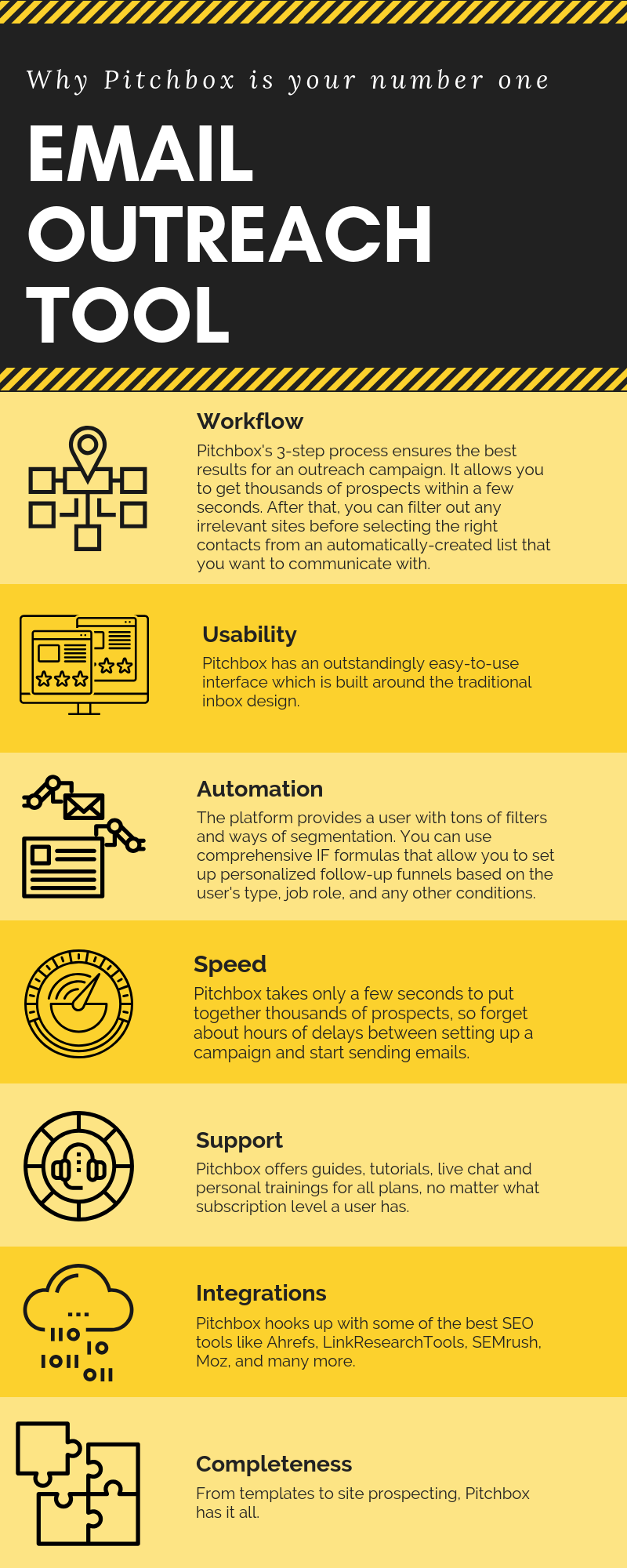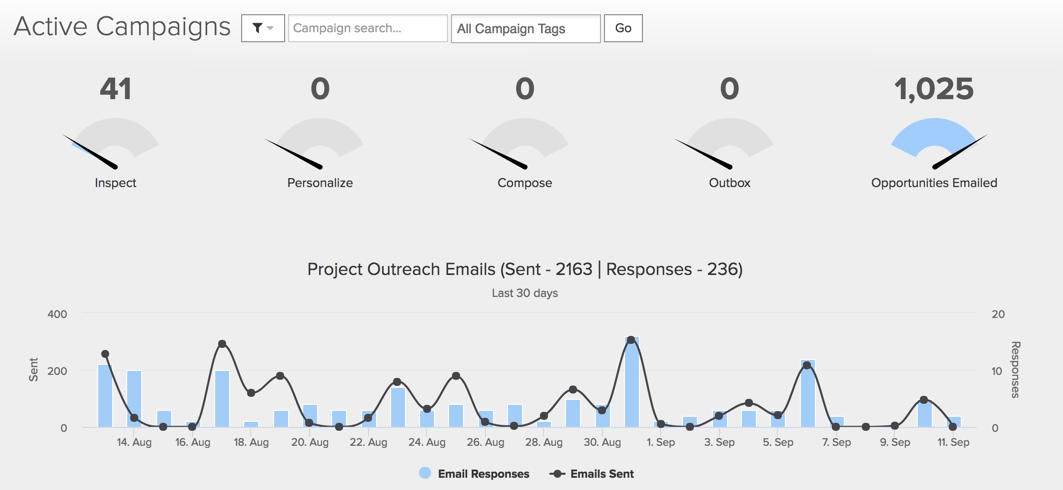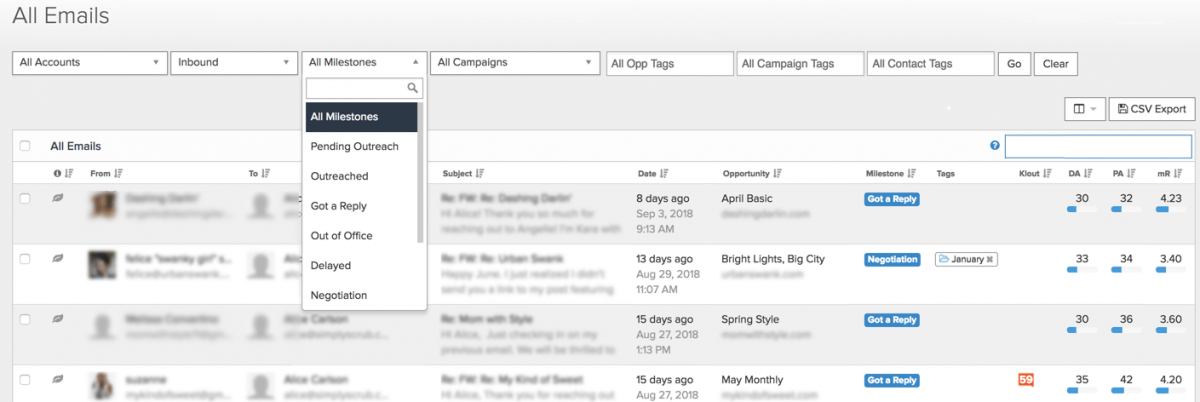Building an All-Star Link Building Team
Learn how to pitchbox like a champ. How a young agency scaled their outreach team and built up to 1000s of links per month with Pitchbox.
Running a Pitchbox-powered outreach agency has taught us a thing or two about how to scale digital PR. We’re now doing outreach for some of the highest trafficked websites in the world.
Link acquisition is a powerful niche tactic that many agencies avoid (or can’t do). Like any great power, it needs to be wielded with care and skill.
We have used Pitchbox to build, structure, train, and reward our outreach link building team. (You know you have a good tool on your hands when “pitchboxing” becomes a verb in your agency…).
I’m going to share some of what we’ve learned in over 2 years of using Pitchbox. From how to organise your outreach team to Pitchbox best practices and routines — here’s how to make the most of Pitchbox for outreach.
Why Pitchbox?
We didn’t latch on to Pitchbox by chance — there was a lot of research & development that went into choosing it as our outreach tool of choice. We signed up for countless free trials, taster sessions, and demo calls, and used prototyping and testing to see which outreach tool would perform the best.*
We settled on Pitchbox for the following reasons:
Workflow — Pre-Pitchbox I was using a combination of scraping tools and email campaigners that weren’t a perfect fit. Pitchbox’s segmentation of processes and features provided an ideal distribution of outreach duties.
Usability — I had to find something that everybody on my team (of varying technical abilities) could comfortably use on a daily basis. Advanced features aside, the traditional inbox design was refreshingly user-friendly.
Automation — Whilst I champion a custom approach, there are some things that just should be automated. The guys at Pitchbox make outreach automation happen.
Speed — The design needed to favour efficiency and scalability — something that Pitchbox does well.
Support — We weren’t looking for a casual solution: we wanted a serious development cycle and enterprise-level support. On this, the Pitchbox team have over-delivered from day one.
Integrations — Outreach is no good without solid data. Pitchbox hooks up with some of my favourite SEO tools like Ahrefs, LRT, and many more.
Completeness — From templates to site prospecting, Pitchbox has it all.
* Don’t skip the research phase! There is no one-size-fits-all outreach methodology, so take time figuring out what makes sense for your niche.
Using Pitchbox
It’s all well and good having a feature-packed tool, but you need to know how to use it effectively. Pitchbox does not build links for you. It enables you to have conversations that can then lead to links.
Outreach workflow
With email outreach, you’re trying to operate at maximum efficiency at all times. Any gaps in the workflow, whilst not immediately noticeable, may surface as bottlenecks weeks down the line. Operating at scale means constant output.
With so many moving parts, it’s important to be able to control each step separately for maximum efficiency. Pitchbox does this well with its segmented 3-stage approach:
Inspect > Personalise > Compose
This separation enables you to segment the work across a diverse team, playing to their individual strengths. It also means that outreach campaigns are kept constantly moving.
Our routines rely on the pipeline and our focus is to constantly keep it topped up. At any given time we’re wrapping up last month, negotiating this month, and planning next month.
When it comes to outreach workflow, it’s all about stopping and starting at the right time in order to control velocity. Open the valve too soon and you’ll be stuck in conversations (negotiations) for too long, leaving warm leads to go cold. Open the valve too late, and you will be scrambling around for results.
Three things we have learned about outreach workflow with Pitchbox:
- When it comes to quality checks and sign-off, we like to empower the outreacher through training and support. 90% of outreach opportunities can be signed off by the outreacher, with the remaining 10% requiring further analysis. This keeps the Inspection stage moving at all times and reduces the risk of bottlenecks forming.
- Chasing is a complex process, completely different to automated follow-ups (which Pitchbox does very well). Chases are designed to engage the recipient in conversation and remove any objections they might have to your pitch/content/idea. It’s worth investing time and effort into perfecting your chasing process as getting this right will help with ROI.
- Forecasting is essential. Outreach never stops, and neither should you. Keep your eyes on the horizon and what’s coming next.
Link building dream team
To run outreach successfully month to month you’re going to need a team with a diverse skill set. You could try to do it all yourself, but I don’t think you’ll get much done.
Segment off tasks and outsource where necessary. This line of work is not cheap, so save where you can.
I started out Pitchboxing on my own: I did the prospecting, pitching — even the content writing — all by myself. This gave me appreciation for the full process, but to scale I knew I had to outsource the aspects that I wasn’t so good at. First, I outsourced the content writing, then the data work, followed by the email negotiations.
I recommend you start building your outreach team the hard way: by doing everything yourself. That’s the only way you can really support your team in getting the best possible results.
You need to learn outreach yourself before you can start to lay down standard operating procedures. If you don’t, your processes and team won’t stand the test of time in terms of efficiency and results.
This initial breakdown of duties has developed over time and now our outreach team consists of the following skillsets:
Senior SEO
SEOs tend to have a million other jobs to do, so for maximum efficiency, they should be involved in key outreach pivot points. SEOs are responsible for ensuring deliverables are being met, and are often the main points of contact when it comes to setting up, changing, or signing off on outreach strategy.
SEOs are the initiators of outreach. Even though they have a very central role to play, they need to also learn how to effectively collaborate with others. Outreach will also test an SEO’s project management skills. In fact, big outreach operations warrant their own project managers.
Duties
- Sell in outreach — they are the best people to explain to prospects and clients the long-lasting benefits of this tactic
- Outreach strategy
- Keyword research
- Anchor text sculpting (sign-off)
- Escalation of conversations both client and campaign-side.
Junior SEO
The main subject matter expert on campaigns, the Junior SEO plays an important role in ensuring campaigns meet SEO and client KPIs. They do the heavy lifting on campaign execution and strategy.
Duties
- Anchor text sculpting — delivery
- Site inspecting (selection of contacts)
- Quarantine and quality checks
- Adhoc keyword research
Campaign Manager
Outreach has a many parallels with PR, so I prefer to select my Campaign Managers from the PR industry. They have strong communication skills, empathy for editors and bloggers, and they understand how to tell stories. Good Campaign Managers must have drive, ambition, and a sales mentality.
They will need to lean on their creativity and drive to find the outreach angles needed to win. Working with a travel blogger is going to be very different from pitching to a tech journalist, so they need to know to how to add value in different ways.
I see the Campaign Manager role as a pivot between the two teams (creative and SEO): kind of like the scrum-half in rugby. They are a hybrid creative marketer.
Duties
- Ideation & storytelling
- Negotiations and pitches
- Template creation
- Chasing & comms
- Managing reports and campaign admin.
Writers
The majority of good link acquisition comes through great content. This obviously requires very good content — enter the writers.
The writers must not only be talented writers, they also need to be strong critical thinkers, analysts — true creatives. Writers won’t just be writing: they are in charge of ideation and editorial strategy.
You need good writers and intelligent thinkers for outreach to work. Writers should always handle editorial negotiations. It’s good for writers to be in the trenches, speaking with their own: editors will spot things like an Oxford comma a mile off.
Many outreachers make the mistake of delegating the negotiation role to the researchers or SEOs. SEOs can be some of the worst people to do outreach negotiations because they are too hooked on links (I’m sure we’ve all received a terrible pitch from an SEO). Writers are great communicators and tend to have more creative charisma.
Editors and senior writers can step in and help steer creative ideas in the right direction.
Personaliser (Data Researcher)
Good outreach starts with good lists. You could write the most persuasive email pitch in the world, but if it lands on in the inbox of the IT guy — they’re not going to appreciate it!
That’s where personalisers come in.
Personalisers are primarily responsible for trimming down the email addresses that Pitchbox picks up. Ideally we want to speak to an editor, a marketing team, or an owner of a smaller blog.
Pitchbox have smashed this workflow feature by allowing you to control access to Pitchbox projects. Using this Pitchbox feature it’s easy to geo-outsource contact researchers, limiting their access to only certain aspects of the project and maintaining client confidentiality.
Due to the nature of the role, you need to watch their performance. We track the following:
- Time spent
- Opportunities researched
- Quality of research (score out of 5).
Personalisers can also take on the following tasks:
- Filling in contact forms
- Populating campaign lists
- Matching or filtering emails (these steps can also be done by a VA).
Creative Team
Whilst not on the outreach frontline, there is a whole creative team to back up the outreach team. They create the stories and the reasons for outreach.
The creative team consists of designers, developers, and content marketers. On the web, content assets and PR hooks for outreach can take a multitude of formats. Think guides, microsites, calculators…
The creative team researches and creates content assets that provide the value proposition for outreach. This asset may take many formats — but a great story is always a good reason to pitch.
Motivation & training
It’s important to keep your outreach team motivated and engaged. We like to champion training and performance incentives — and Pitchbox is the perfect platform to enable these.
- It’s recommended that you create your own internal training videos and docs on top of the awesome team training you already get from Pitchbox.
- The helpful Pitchbox support team are a lifesaver — it’s easy for team members to reach out directly and get one-on-one support. Encourage your team to make the most of it.
- Having realtime data from Pitchbox to means I can accurately pinpoint who has done what. This makes it easy to give precise positive feedback, as well as identify any performance gaps. We have built-in targets and incentives so that the teams stay accountable.
- We like to operate our outreach team as a performance model. We grade staff and have a monthly bonus scheme based on built links. Team performance is the number one productivity booster — we want to reward success. That’s why we love the Pitchbox team performance features that help us plan and manage individual workloads.
Efficiency of scale with Pitchbox
Outreach is a costly process. To become a successful outreach agency, we knew we needed to be able to do outreach more cost-effectively than brands could do in-house.
That’s why it’s important to optimise the process for efficiency as much as possible. Small inefficiencies in the process can add up and cost you time and money. To scale the unscalable we had to iron out each tiny little micro-process.
This is where economies of scale come in — and why only a small number in the industry do outreach well. Pitchbox is very scale-friendly and scalable…
SOPs (Standard Operating Procedures)
You need to set out great SOPs that match onto Pitchbox in order to scale successfully.
Pitchbox has already done 90% of this for you: they know outreach inside out, and all the key processes are built into the platform.
Process everything, limit decision-making, and account for all possible scenarios. Think about all the different moving cogs in the outreach process — and make sure they are all accounted for.
You need to know how to react to any given situation — think about the “actions on” every specific scenario. What do you do when someone strips your links? What do you do when a prospect goes cold? What do you do when someone is pushing for more data or credentials?
Know how to react effectively to each situation. Document everything so that you can improve and delegate where you can.
Word of warning: You can plan for some things — but a big element of outreach is always going to be reactive. Don’t get stuck in analysis paralysis.
Pitchbox process hacks from the process pro
- Tie in Pitchbox milestones to your own internal ones
- Give VAs controlled access to maintain client integrity
- Record a detailed training video for each stage of the outreach process
- Use the Pitchbox reporting features to forecast and manage your workflow
Work smarter, not harder
Procedures are there for a reason — so that you can work smarter, not harder. We like to focus on finding new ways of getting the same results — or even better, getting better results.
A good example of this is our way of maximising Pitchbox’s filtering features. The trick is to shift lots of data first, so that you can then get the right members of the team to continue with the high-value conversations. Use the inbox feature to identify the nature of the conversation from the preview and then select multiple rows to mark up as a specific milestone (Out of Office, Negotiation, Lost, Delayed etc). Move the big datasets first, and then get more precise.
Educate clients on the benefits and processes of outreach. They need to commit to creating great content and embracing the concept of value exchange. The more informed clients are about the mechanics and value of outreach, the easier they will find it.
Routines
Routines will keep your outreach operations from going haywire. Make sure that there is a daily practice of checking in on conversations with your team. Be mindful of timezones and how that impacts conversations.
Be strict when it comes to content deadlines and asset creation. Delay on the content end can spell outreach disaster, so good project management and tracking are key.
Data Integrity
Consistency is important. Every day our service becomes more valuable as we take on new niches and our footprint on the web increases.
For this to happen, we need to be very well organised with tagging and milestone updates. The higher the quality of the data, the easier it is to use in future. Pitchbox is great at building in that longevity and transparency with their data driven approach to outreach.
Summary
We love Pitchbox not only for all the reasons we have laid out already, but also because they have a rapid development cycle. It has happened to us many times — one day we log in, and there is a brilliant new feature waiting for us. For a growing agency, it’s been a lifeline as we scaled up hard.
Pitchbox is an undeniable powerhouse, but you need to become a power user if you want to make the most of it. You need to put in the hard graft and do not expect Pitchbox to do outreach for you.
And you have to remember that outreach itself is changing. The market is getting saturated, so it is important to stand out with the value and quality of your outreach. Keep building on existing processes and looking to the future.
We are obviously big fans of Pitchbox, so if you want to find out more about running campaigns on Pitchbox, get in touch with us over at Seeker Digital.



